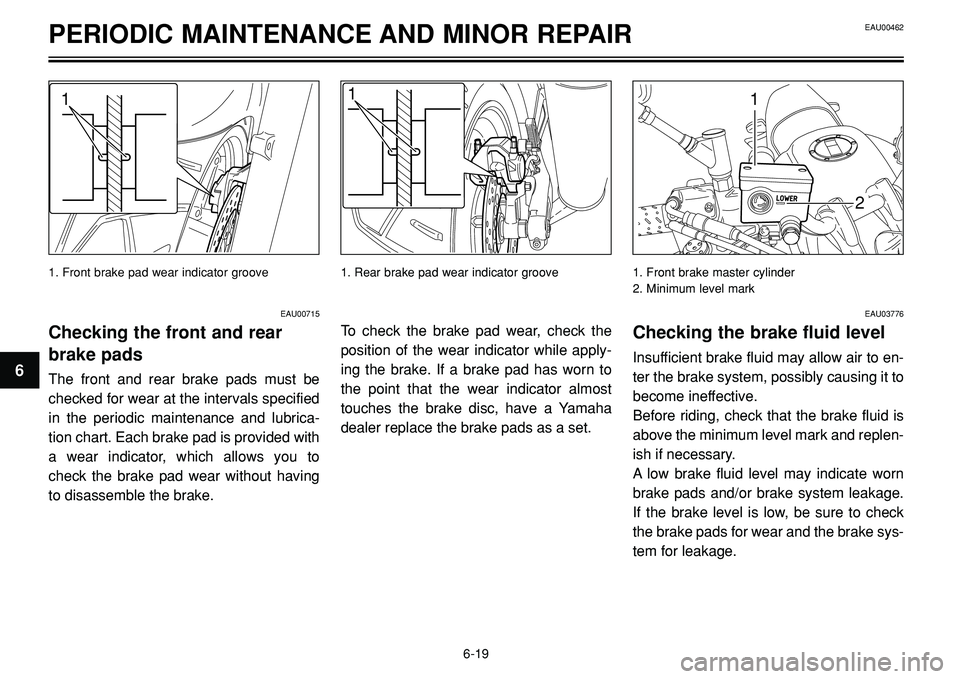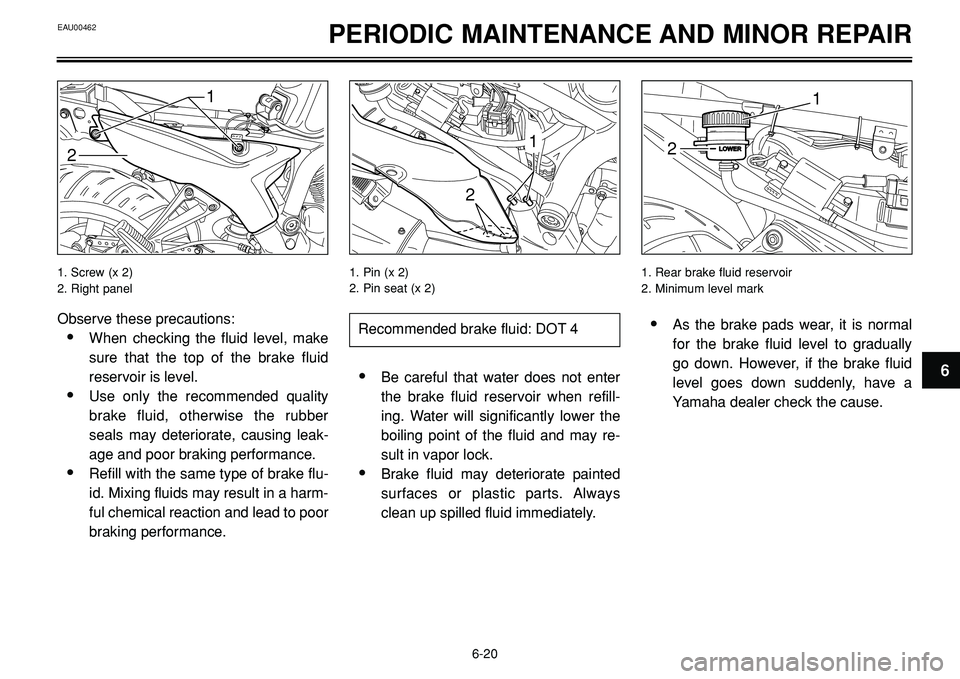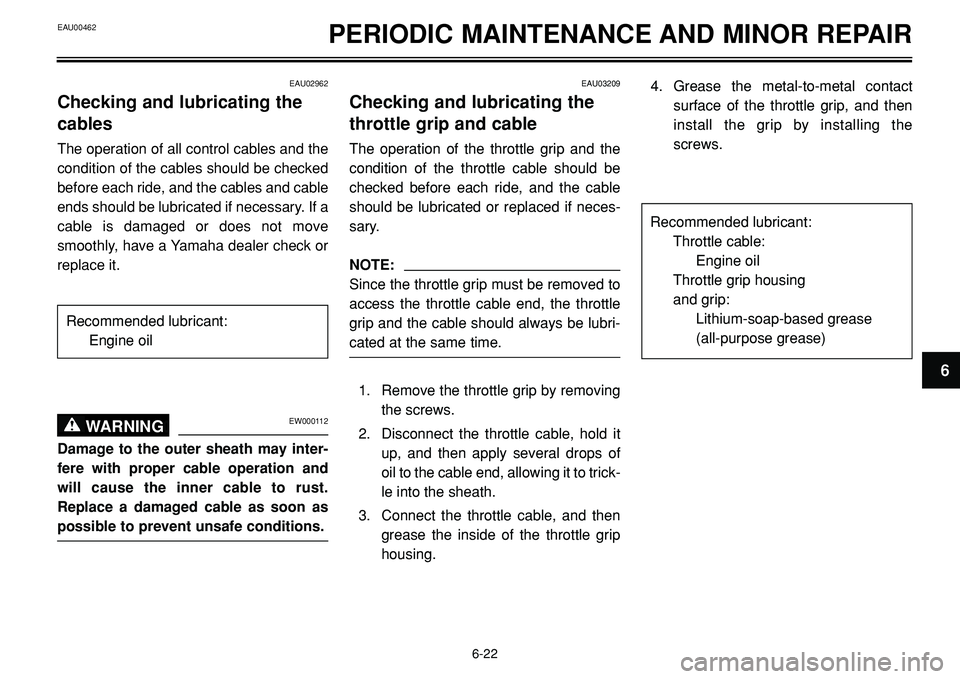Page 57 of 96

EAU00462PERIODIC MAINTENANCE AND MINOR REPAIR
NOTE:
The tire tread depth limits may differ from
country to country. Always comply with the
local regulations.
EW000079WARNING0
•Have a Yamaha dealer replace
excessively worn tires. Besides
being illegal, operating the motor-
cycle with excessively worn tires
decreases riding stability and can
lead to loss of control.
•The replacement of all wheel- and
brake-related parts, including the
tires, should be left to a Yamaha
dealer, who has the necessary pro-
fessional knowledge and experi-
ence.
Tire information
This motorcycle is equipped with cast
wheels and tubeless tires with valves.
EW000080WARNING0
•The front and rear tires should be
of the same make and design, oth-
erwise the handling characteris-
tics of the motorcycle cannot be
guaranteed.
•After extensive tests, only the tires
listed below have been approved
for this model by Yamaha Motor
Co., Ltd.
•Always make sure that the valve
caps are securely installed to pre-
vent air pressure leakage.
•Use only the tire valves and valve
cores listed below to avoid tire
deflation during a high-speed ride.
6-15
6
Tire inspection
The tires must be checked before each ride.
If the center tread depth reaches the speci-
fied limit, if the tire has a nail or glass frag-
ments in it, or if the sidewall is cracked,
have a Yamaha dealer replace the tire im-
mediately.
1. Tire sidewall
a. Tire tread depth
Minimum tire
tread depth 1.6 mm
(front and rear)
Page 58 of 96

EAU00462PERIODIC MAINTENANCE AND MINOR REPAIR
EAU00684WARNING0
•This motorcycle is fitted with
super-high-speed tires. Note the
following points in order to make
the most efficient use of these
tires.
•Use only the specified replace-
ment tires. Other tires may run the
danger of bursting at super high
speeds.
•Brand-new tires can have a rela-
tively poor grip on certain road
surfaces until they have been
“broken in”.
•Therefore, it is advisable before
doing any high-speed riding to
ride conservatively for approxi-
mately 100 km (60 mi) after
installing a new tire.
•The tires must be warmed up
before a high-speed run.
•Always adjust the tire air pressure
according to the operating condi-
tions.
EAU03773
Cast wheels
To maximize the performance, durability,
and safe operation of your motorcycle,
note the following points regarding the
specified wheels.
The wheel rims should be checked for
cracks, bends or warpage before each
ride. If any damage is found, have a Yama-
ha dealer replace the wheel. Do not at-
tempt even the smallest repair to the
wheel. A deformed or cracked wheel must
be replaced.
The wheel should be balanced whenever
either the tire or wheel has been changed
or replaced. An unbalanced wheel can re-
sult in poor performance, adverse han-
dling characteristics, and a shortened tire
life.
6-16
6
FRONT
REAR
Manufacturer Size Type
Dunlop 120/70-ZR17 (58W) D205F TL
Metzeler 120/70-ZR17 (58W) MEZ3F TL
Manufacturer Size Type
Dunlop 170/60-ZR17 (72W) D205 TL
Metzeler 170/60-ZR17 (72W) MEZ3 TL
Page 59 of 96
EAU00462PERIODIC MAINTENANCE AND MINOR REPAIR
2
1
c
b
a
Ride at moderate speeds after changing a
tire since the tire surface must first be “bro-
ken in” for it to develop its optimal charac-
teristics.
1. Locknut
2. Free play adjusting bolt
c. Clutch lever free play
EAU00692
Adjusting the clutch lever
free play
The clutch lever free play should measure
5-10 mm as shown. Periodically check the
clutch lever free play and, if necessary, ad-
just it as follows.1. Loosen the locknut at the clutch lever.
2. To increase the clutch lever free play,
turn the adjusting bolt in direction a.
To decrease the clutch lever free play,
turn the adjusting bolt in direction b.
3. Tighten the locknut.
NOTE:
If the specified free play cannot be
obtained as described above or if the
clutch does not operate correctly, have a
Yamaha dealer check the internal clutch
mechanism.
6-17
6
Page 60 of 96
EAU00462PERIODIC MAINTENANCE AND MINOR REPAIR
A
a
EAU00712
Adjusting the brake pedal
position
The top of the brake pedal should be posi-
tioned approximately 43 mm below the top
of the footrest as shown. Periodically
check the brake pedal position and, if nec-
essary, have a Yamaha dealer adjust it.
EW000109WARNING0
A soft or spongy feeling in the brake
pedal can indicate the presence of air
in the hydraulic system. If there is air in
the hydraulic system, have a Yamaha
dealer bleed the system before operat-
ing the motorcycle. Air in the hydraulic
system will diminish the braking per-
formance, which may result in loss of
control and an accident.a. Distance between brake pedal and footrest
6-18
6
Page 61 of 96

1. Front brake pad wear indicator groove
PERIODIC MAINTENANCE AND MINOR REPAIR
11
2
1
EAU00715
Checking the front and rear
brake pads
The front and rear brake pads must be
checked for wear at the intervals specified
in the periodic maintenance and lubrica-
tion chart. Each brake pad is provided with
a wear indicator, which allows you to
check the brake pad wear without having
to disassemble the brake. To check the brake pad wear, check the
position of the wear indicator while apply-
ing the brake. If a brake pad has worn to
the point that the wear indicator almost
touches the brake disc, have a Yamaha
dealer replace the brake pads as a set.
EAU03776
Checking the brake fluid level
Insufficient brake fluid may allow air to en-
ter the brake system, possibly causing it to
become ineffective.
Before riding, check that the brake fluid is
above the minimum level mark and replen-
ish if necessary.
A low brake fluid level may indicate worn
brake pads and/or brake system leakage.
If the brake level is low, be sure to check
the brake pads for wear and the brake sys-
tem for leakage.
EAU00462
6-19
6
1. Front brake master cylinder
2. Minimum level mark 1. Rear brake pad wear indicator groove
Page 62 of 96

EAU00462PERIODIC MAINTENANCE AND MINOR REPAIR
1
2
Observe these precautions:
•When checking the fluid level, make
sure that the top of the brake fluid
reservoir is level.
•Use only the recommended quality
brake fluid, otherwise the rubber
seals may deteriorate, causing leak-
age and poor braking performance.
•Refill with the same type of brake flu-
id. Mixing fluids may result in a harm-
ful chemical reaction and lead to poor
braking performance.
•Be careful that water does not enter
the brake fluid reservoir when refill-
ing. Water will significantly lower the
boiling point of the fluid and may re-
sult in vapor lock.
•Brake fluid may deteriorate painted
surfaces or plastic parts. Always
clean up spilled fluid immediately.
•As the brake pads wear, it is normal
for the brake fluid level to gradually
go down. However, if the brake fluid
level goes down suddenly, have a
Yamaha dealer check the cause.
6-20
6
1. Screw (x 2)
2. Right panel
2
1
1. Pin (x 2)
2. Pin seat (x 2)
Recommended brake fluid: DOT 4
21
1. Rear brake fluid reservoir
2. Minimum level mark
Page 63 of 96
EAU00462PERIODIC MAINTENANCE AND MINOR REPAIR
a
A
EAU03976
Changing the brake fluid
Have a Yamaha dealer change the brake
fluid at the intervals specified in the NOTE
after the periodic maintenance and lubri-
cation chart. In addition, have the oil seals
of the master cylinders and calipers as
well as the brake hoses replaced at the in-
tervals listed below or whenever they are
damaged or leaking.
•Oil seals: Replace every two years.
•Brake hoses: Replace every four
years.
a. Distance between shift pedal and footrest
EAUB0011
Adjusting the shift pedal
position
The top of the shift pedal should be posi-
tioned approximately 45 mm below the top
of the footrest as shown. Periodically check the shift pedal position
and, if necessary, have a Yamaha dealer
adjust it.
6-21
6
Page 64 of 96

EAU00462PERIODIC MAINTENANCE AND MINOR REPAIR
EAU02962
Checking and lubricating the
cables
The operation of all control cables and the
condition of the cables should be checked
before each ride, and the cables and cable
ends should be lubricated if necessary. If a
cable is damaged or does not move
smoothly, have a Yamaha dealer check or
replace it.
EW000112WARNING0
Damage to the outer sheath may inter-
fere with proper cable operation and
will cause the inner cable to rust.
Replace a damaged cable as soon as
possible to prevent unsafe conditions.
EAU03209
Checking and lubricating the
throttle grip and cable
The operation of the throttle grip and the
condition of the throttle cable should be
checked before each ride, and the cable
should be lubricated or replaced if neces-
sary.
NOTE:
Since the throttle grip must be removed to
access the throttle cable end, the throttle
grip and the cable should always be lubri-
cated at the same time.
1. Remove the throttle grip by removing
the screws.
2. Disconnect the throttle cable, hold it
up, and then apply several drops of
oil to the cable end, allowing it to trick-
le into the sheath.
3. Connect the throttle cable, and then
grease the inside of the throttle grip
housing.4. Grease the metal-to-metal contact
surface of the throttle grip, and then
install the grip by installing the
screws.
6-22
6
Recommended lubricant:
Engine oil
Recommended lubricant:
Throttle cable:
Engine oil
Throttle grip housing
and grip:
Lithium-soap-based grease
(all-purpose grease)